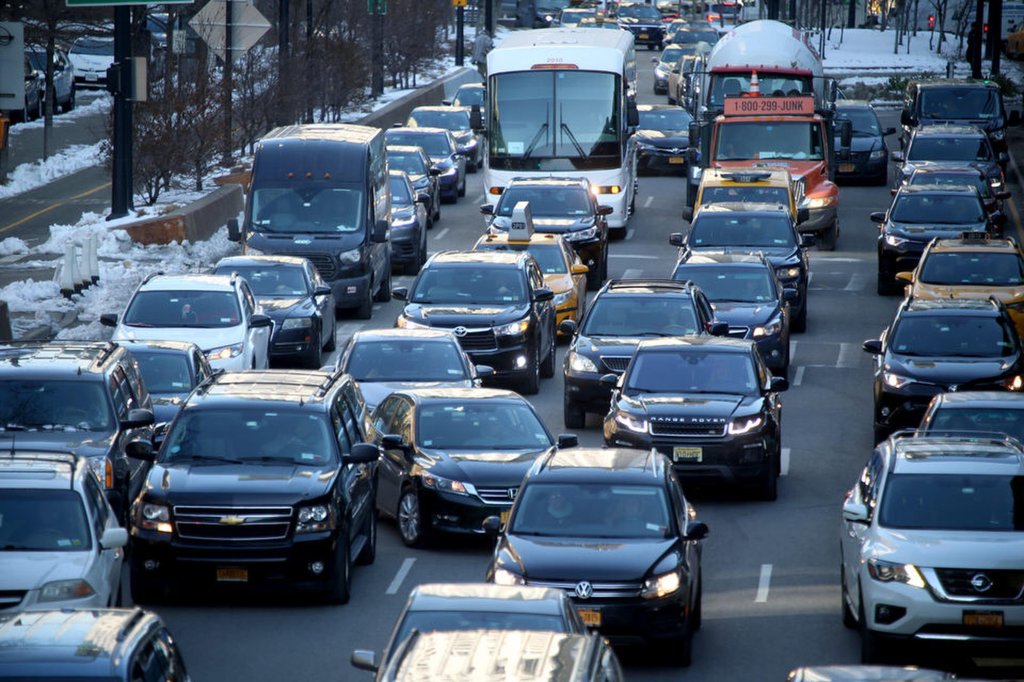Gov. Hochul’s decision to pause the implementation of congestion pricing last month has put the plan to unclog NYC’s streets — and the promise of billions of dollars to modernize our transit system — on life support.
However, traffic congestion itself is thriving. Following a pandemic dip, car and truck traffic in the city is back and setting new records. City drivers spent more than 100 hours sitting in traffic jams in 2023 and travel speeds in the city are slower than they’ve ever been.
The effects of congestion are serious; it’s not just lost time. Pollution from traffic contributes to hundreds of premature deaths and emergency room visits and hospitalizations each year. The psychiatric and physical toll of air and noise pollution is real. And 10 years after NYC pledged to pursue Vision Zero, our congestion crisis means that too many New Yorkers — car drivers, bicyclists, and pedestrians — are still dying from vehicle collisions.
Traffic congestion is also choking our local businesses to the tune of $20 billion each year, according to the Partnership for New York City.
With congestion pricing on pause, it is time to envision a new plan to deal with congestion and all of the problems it causes. Because I don’t think that anyone, including New Yorkers who commute by car every day, want to spend time in a city that forces people to endure hours-long traffic jams.
Luiz C. Ribeiro for NY Daily News
Thousands of cars are seen packing the FDR Drive during rush hour traffic congestion early Monday, July 8, 2024, near Gracie Mansion, the official New York City mayor’s residence.
If we squint just hard enough, we can see an alternative to our congested reality starting to take shape. The Paseo Park, which stretches for 26 blocks along 34th Ave. in Jackson Heights is perhaps the most tangible example of one community’s efforts to redesign roadways in favor of pedestrians, children playing, and bicycles over cars.
Major stretches of Broadway have been redesigned to reduce, and at times eliminate, car traffic. Traffic reduction changes on Broadway, in Times Square, and key crosstown streets like 14th St., initially met opposition, but are now welcomed by local residents and business-owners alike.
The Hudson Square neighborhood where I work is a poster child for the future of New York City’s Central Business District, centered on innovative businesses like Supreme and BioLabs, not to mention Google and Disney, both of which have new headquarters in the neighborhood.
As the city’s former printing district, our neighborhood has the kind of large, open floor plates that companies want. But our streets, even more so than other neighborhoods, were designed for trucks, not pedestrians. Our mission has been to flip that equation.
We dramatically redesigned Hudson St., one of our central thoroughfares. We added wide sidewalks with benches and state-of-the-art pits for plants and trees; the streets themselves now feature a dedicated, parking-protected bike lane.
Ironically, from the southern end of the now beautiful, tree-lined, people-centered Hudson St., you get a front-row seat to the traffic ritual that has been observed daily since 1927 when the Holland Tunnel first opened. Starting at 3 p.m. or so, movement on half of the streets slams to a halt as cars and trucks wait for their turn to enter New Jersey.
I don’t claim that we can fully reduce traffic congestion around major entry points like the Holland Tunnel. But we can reduce it.
Congestion levels must be lower to make streets safer for all users. Canal St., for instance, will remain a nightmare for pedestrians, drivers and cyclists, from the Hudson to the East River, so long as traffic flowing through the city remains the same.
There is much more we can do to improve our streets around these clogged arteries. For one, we should prohibit parking within 20 feet of a city crosswalk, a concept known as daylighting which has helped Hoboken reduce its traffic fatalities to zero for seven years running.
We can also expand micro mobility initiatives like Citi Bike which offer new, greener ways to get around city streets. Citi Bike, which launched in 2013, had more than 4 million rides in May, with nearly 44,000 of those trips starting or ending in Hudson Square.
There are many tools we can use to fix our growing congestion problem and make our streets healthier and safer for everyone. Now is the time to develop a comprehensive, citywide plan to get that done.
Karasyk is president and CEO of the Hudson Square Business Improvement District.
